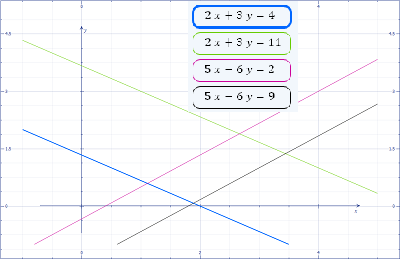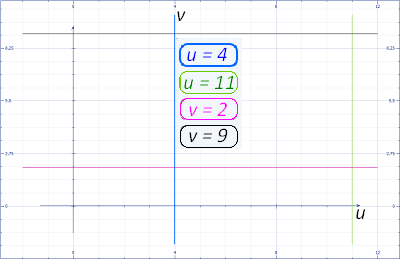
and

Here is a specific problem:
| Find a change of variables for
`2x+3y=4` and `2x+3y=11` and `5x-6y=2` and `5x-6y=9` | |||
| To do this let | `u=2x+3y` `v=5x-6y` |
(1) | |
| Let us eliminate `y` To do this we multiply top equation by `2` | `2u=4x+6y` `v=5x-6y` |
(2) | |
| Add the two equations to eliminate the y's | `2u + v = 9x` | (3) | |
| or | `x = (1/9)(2u +v)` | (4) | |
| Then we want to solve for y We could do this in different ways
multiply the top equation in (1) by 5 and the bottom by -2 | `5u=10x+15y` `-2v=-10x+12y` |
(5) | |
| Add the two equations to eliminate the x's | `5u - 2v = 27y` | (6) | |
| or | `y = (1/27)(5u - 2v)` | (7) | |
| Return to the original equations, and change variables | |||
| `2x+3y=4` yields | `2( (1/9)(2u+v) ) + 3( (1/27)(5u - 2v) ) = 4` | (8) | |
| Multiply both sides by 9 to give | `2( 2u+v ) + (5u - 2v) = 36` `4u + 2v +5u -2v = 36` `9u = 36` `u=4` |
(9) | |
| `2x+3y=11` yields | `2( (1/9)(2u+v) ) + 3( (1/27)(5u - 2v) ) = 11` | (10) | |
| Multiply both sides by 9 to give | `2( 2u+v ) + (5u - 2v) = 99` `4u + 2v +5u -2v = 36` `9u = 99` `u=11` |
(11) | |
| `5x-6y=2` yields | `5( (1/9)(2u+v) ) - 6( (1/27)(5u - 2v) ) = 2` | (12) | |
| Multiply both sides by 9 to give | `5( 2u+v ) -+ 2(5u - 2v) = 18` `10u - 5v - 10u + 4v = 18` `9v = 18` `v=2` |
(13) | |
| `5x-6y=9` yields | `5( (1/9)(2u+v) ) - 6( (1/27)(5u - 2v) ) = 9` | (14) | |
| Multiply both sides by 9 to give | `5( 2u+v ) -+ 2(5u - 2v) = 81` `10u - 5v - 10u + 4v = 81` `9v = 81` `v=9` |
(15) | |
Here are images of plots of the original equations and of the
transformed versions of the same:

and

We can actually go backwards at this time to find the coordinates of the corners of the parallelogram in the `xy`-plane from the corners of the rectangle in the `uv`-plane: To do this we can use the equations `x=(1/9)(2u+v)` and `y=(1/27)(5u-2v)`.
| `(u,v)=(4,2)` `(x,y)=(10/9,16/27)` |
`(u,v)=(4,9)` `(x,y)=(17/9,2/27)` |
`(u,v)=(11,2)` `(x,y)=(24/9,51/27)` |
`(u,v)=(11,9)` `(x,y)=(31/9,37/27)` |
The rectangle in the `uv`-plane is a nice region, namely, it is a 7 by 7 square with area equal to 49 square units. The parallelogram in th `xy`-plane poses challenges in terms of finding its area.
The tansformations that we found, expressed as
`x=(1/9)(2u+v)` and `y=(1/27)(5u-2v)`
can be used to find the Jacobian of `x` and `y` with respect to `u` and `v`.
`(del(x,y))/(del(u,v)) = |[(del x)/(del u),(del x)/(del v)],[(del y)/(del u),(del y)/(del v)]| = (del x)/(del u) (del y)/(del v) - (del y)/(del u) (del x)/(del v) `
`(del(x,y))/(del(u,v)) = |[2/9,1/9],[5/27,(-2)/27]| = 2/9 *(-2)/27 - 1/9 * 5/27 = (-4)/(9*27) - 5/(9*27) = (-9)/(9*27) =-1/27`
Then, the change of variables theorem gives us the general statement
`int_Rintf(x,y)dxdy = int_Sintf(g(u,v),h(u,v))|(del(x,y))/(del(u,v))| du dv`
And, in this particular case, where we know the Jacobian, to find the area of `R` we have `f(x,y)=1` which means that `f(g(u,v),h(u,v))=1` so we are looking at
`int_Rintdxdy = int_Sint|(-1)/27| du dv =|-1/27|int_Sint du dv`
However, as noted above, the area of `S` is 49 square units, so the area of `R` must be `49/27`. Fortunately for us, we have an alternative method of finding the area of `R` so we can check our work. In particular, if we look at the two vectors that form adjacent sides of the parallelogram `R` we can compute the area of the parallelogram by looking at the magnitude of the cross product of those vectors. Using the point `(10/9,16/27,0)` [note that we express this in three dimensions so that we can take a cross-product] as the start of the two vectors, we get the vector to the point `(24/9,51/27,0)` as `(:14/9,35/27,0:)` and the vector to the point `(17/9,2/27,0)` as `(:7/9,(-14)/27,0:)`. The cross product of these two vectors is `(:0,0,(14*14)/(9*27)-(35/27)*(7/9):)` which simplifies to `(:0,0,49/27:)` and the magnitude of that vector is just `49/27`, confirming our earlier work.
©Roger M. Palay
Saline, MI 48176
July, 2012